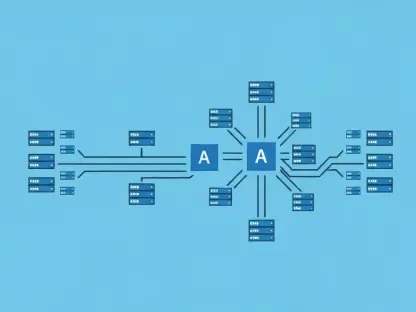The Generative AI (Gen AI) in software development market is poised for remarkable growth, projected to reach $126.34 billion by 2030. This impressive trajectory highlights the increasing adoption and integration of AI technology across various sectors. An analysis by Arizton underscores the transformational impact of Gen AI on numerous industries, providing an in-depth look at market dynamics, regional outlooks, key drivers, and recent advancements. This analysis sheds light on how generative AI is fundamentally revolutionizing software development and various other industry sectors.
Market Growth and Forecast
The Generative AI market is expected to grow at a compound annual growth rate (CAGR) of 16.71% from 2024 to 2030, driven by the burgeoning demand for intelligent and automated solutions. With a baseline market size valued at $50 billion in 2024, the projected growth exemplifies a substantial revenue opportunity. The rising need for automated systems that can handle more complex tasks and create innovative solutions is fueling this expansive growth. Additionally, the adoption of AI in areas such as content generation, predictive modeling, and automated coding contributes to this significant market expansion.
The relentless push toward digital transformation across enterprises and industries further accentuates the necessity for advanced Gen AI technologies. Companies are increasingly investing in AI-driven solutions to enhance efficiency, reduce operational costs, and foster innovation. This strong investment trend is another critical factor that bolsters the projected market growth, making Gen AI an indispensable tool in the contemporary digital economy. As AI technology continues to evolve, its applications are expected to broaden, driving new revenue streams and solidifying its position in the software development market.
Market Segmentation and Components
Understanding the market requires an analysis of its segmentation by components, deployment modes, and technologies. Solutions and services form the core components, offering businesses tailored packages to meet their specific needs. Deployment modes are categorized into cloud-based and on-premises, providing flexible options for enterprises depending on their infrastructure and data management preferences. Key technologies propelling this market include Generative Adversarial Networks (GANs), Transformer-based Gen AI Software, Variational Auto-Encoders, and Diffusion Networks. Each technology brings its unique capabilities, making Gen AI more versatile and powerful.
The segmentation also extends to models, such as Large Language Models, Image & Video Generative Models, and Multi-modal Generative Models. These models cater to different application needs, from text and image generation to complex multimodal interactions. The diversity in Gen AI models and technologies allows companies to leverage AI innovations tailored to their industry requirements, enhancing productivity and driving competitive advantages. This comprehensive segmentation underscores the multifaceted nature of the Gen AI market, highlighting its capacity to address various business challenges and opportunities in the digital era.
Regional Analysis
North America emerges as a dominant player within the global Gen AI landscape, with the United States accounting for over 78% of regional revenue. This dominance is driven by rapid technological advancements and widespread enterprise adoption of AI solutions. Major tech giants like OpenAI, Microsoft, and Google Cloud play pivotal roles in propelling the market forward through continuous innovation and large-scale deployment of AI technologies. These companies are leading the charge in integrating Gen AI into diverse business processes, setting benchmarks for the rest of the industry.
Europe, the Asia-Pacific (APAC) region, Latin America, and the Middle East & Africa are also key areas of growth, each contributing uniquely to the global market expansion. Europe benefits from strong research initiatives and governmental support for AI innovation. The APAC region, led by countries like China and Japan, is experiencing rapid adoption of AI in industries such as manufacturing and retail. Latin America and the Middle East & Africa are gradually emerging as important players, driven by increasing investments in AI infrastructure and growing tech-savvy populations. This regional diversity highlights the global appeal and potential of Gen AI technologies.
Integration with Industry Sectors
The adaptability of Gen AI extends across multiple industries, enhancing functionalities and driving efficiency. In healthcare, it aids in patient data and image analysis, significantly supporting medical professionals in diagnostics and treatment planning. AI-driven predictive analytics in healthcare improves patient outcomes and operational efficiency, presenting a transformative force in this critical sector. Gen AI also plays a pivotal role in the marketing domain, accelerating content creation and optimization. Through automated tools, marketers can quickly generate ad copy, visuals, and video content, enhancing campaign effectiveness and speed.
The education sector similarly benefits from the integration of Gen AI, which offers interactive AI-powered lessons that incorporate text, audio, and video. This technology facilitates personalized and engaging learning experiences, catering to individual student needs and fostering better educational outcomes. Additionally, Gen AI’s impact on customer service is profound. AI-driven systems can handle a wide range of customer interactions, from answering queries to problem resolution, significantly improving response times and customer satisfaction. This multifunctionality of Gen AI showcases its widespread applicability and its potential to revolutionize various industry sectors.
Impact on Education and Customer Service
Gen AI’s influence on the education sector is significant, offering interactive and tailored learning experiences through AI-powered lessons that integrate text, audio, and video. These advancements enable personalized education, catering to students’ unique learning paces and styles, which enhances engagement and retention. With AI-driven tutoring and feedback systems, educators can provide more focused support, addressing individual challenges and promoting a deeper understanding of subjects. This transformation in the educational landscape brings innovative tools and methodologies, paving the way for more effective and inclusive education systems.
Customer service systems leverage Gen AI to become smarter and more adaptive, fundamentally improving user experiences. AI-powered chatbots and virtual assistants can handle a broad spectrum of customer inquiries, providing instant responses and efficient problem-solving. This capability not only enhances customer satisfaction but also allows businesses to operate more efficiently by freeing up human resources for more complex tasks. Additionally, advanced AI systems can learn from interactions, continuously improving their performance and providing more accurate and relevant responses over time. This adaptability and continuous learning make Gen AI an invaluable asset in customer service.
Market Trends
Several significant trends define the trajectory of the Gen AI market, shaping its development and application across various sectors. The rise of multimodal AI is particularly noteworthy, as it processes and understands various data types such as text, images, audio, and video. This capability enhances content creation, audience engagement, and search functionalities, making AI tools more versatile and applicable across different domains. The integration of multimodal AI allows for more complex and nuanced data analysis, resulting in more effective and innovative solutions.
Emerging trends also include ethical AI practices, real-time interactions, multilingual support, and AI-generated multimedia content. Ethical AI practices are increasingly critical as companies strive to ensure that their AI systems are transparent, fair, and unbiased. Real-time interactions enable more dynamic and responsive AI applications, improving user experiences and operational efficiencies. Multilingual support broadens the applicability of Gen AI tools, allowing them to cater to diverse global audiences. The trend toward AI-generated multimedia content facilitates more creative and efficient content production processes, enhancing the quality and variety of digital media available.
Multimodal Gen AI
A major overarching trend is the rise of multimodal Gen AI, which profoundly impacts market growth. This technology combines natural language processing (NLP), computer vision, speech recognition, and machine learning to provide comprehensive insights and generate multimedia content from simple text prompts. The ability to process and synthesize information from various data types makes multimodal AI exceptionally valuable in creating more sophisticated and versatile applications. Its integration into different sectors exemplifies its adaptability and expansive utility, driving significant advancements in user engagement and content quality.
The widespread application of multimodal AI in diverse industries showcases its capacity to revolutionize traditional processes and create new opportunities for innovation. In entertainment, AI can generate realistic visual effects and immersive environments. In e-commerce, it can enhance product recommendations through detailed analysis of user interactions. The potential of multimodal AI to offer holistic solutions underscores its role in shaping the future of the Gen AI market, making it a cornerstone of ongoing technological advancements and industry transformation.
Technological Innovation and Development
Continuous innovation by leading companies, including OpenAI, Google, Microsoft, and Adobe, drives market expansion. These enterprises are at the forefront of developing sophisticated AI models and integrating them into their solutions, stimulating significant technological advancements. OpenAI’s advancements in large language models and Google’s innovations in multimodal AI exemplify the rapid progress being made in this field. These companies’ commitment to research and development ensures that AI technologies remain cutting-edge, competitive, and capable of addressing complex industry needs.
The development of more advanced AI tools and their seamless integration into various applications highlight the dynamic and evolving nature of the Gen AI market. As these technologies become more sophisticated, they offer more precise and efficient solutions, driving adoption across different sectors. This continuous innovation not only enhances existing processes but also opens new avenues for AI applications, further accelerating market growth and solidifying the strategic importance of Gen AI in the contemporary technology landscape.
Automation and Personalization
Increasing automation in content generation and delivering hyper-personalized experiences at scale are vital strengths of the Gen AI market. These capabilities streamline operations and enhance user experience, profoundly influencing sectors like e-commerce, digital advertising, and software development. AI-driven automation reduces the time and effort required for content creation, enabling businesses to produce high-quality materials more efficiently. This not only boosts productivity but also allows for more creativity and innovation in content strategies.
Hyper-personalization, enabled by AI’s ability to analyze vast amounts of data and predict user preferences, enhances customer engagement and satisfaction. By delivering tailored content and experiences, businesses can build stronger connections with their audiences and improve customer loyalty. This approach is particularly impactful in e-commerce, where personalized recommendations and targeted marketing campaigns can significantly increase sales and customer retention. The ability of Gen AI to provide both automation and personalization underscores its transformative potential in optimizing business processes and enhancing user experiences.
Recent Developments
Recent advancements in the Gen AI market highlight the innovative momentum driving this sector. For example, in February 2024, Google DeepMind released Gemini 1.5, an advanced multimodal large language model (LLM) that supports high-quality reasoning across numerous data types including text, code, and images. This development represents a significant leap in AI’s ability to understand and process complex and varied information, showcasing the potential of multimodal AI to revolutionize content creation and data analysis.
Similarly, in January 2024, Microsoft/OpenAI introduced Copilot Pro integration into Microsoft 365, enhancing productivity tools like Word and Excel with real-time generative capabilities. This integration enables users to streamline their workflow, automatically generating content and providing intelligent suggestions to improve efficiency and accuracy. In November 2023, Adobe unveiled Firefly AI, a suite of generative design tools integrated into Photoshop and Illustrator, which allows designers to transform text into creative images and visuals. These developments exemplify the rapid pace of innovation in the Gen AI market and its far-reaching implications for various industries.
Conclusion
The Generative AI (Gen AI) market in software development is set for significant expansion, with projections estimating it will soar to $126.34 billion by 2030. This anticipated growth underscores the widespread adoption and integration of AI technology in numerous sectors. An analytical report by Arizton delves into the transformative influence of Gen AI on various industries, offering a detailed examination of market dynamics, regional perspectives, key motivators, and recent technological advancements. This exploration highlights how generative AI is not only revolutionizing software development but is also having a profound impact across multiple industry domains. The insights provided by Arizton offer a comprehensive understanding of how Gen AI is reshaping the landscape of software development and beyond, paving the way for innovative applications and solutions that enhance productivity and efficiency. As AI technology continues to evolve, its potential to drive change and create new opportunities remains vast, making it a key focus for businesses and developers alike.









